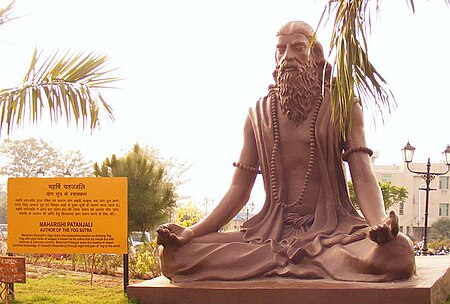Beyond asanas: Yoga is a holistic, 8-limbed system
Sage Patanjali, the author of Yoga sutras, envisioned yoga as an eight limbed system .
.png) The eight limbs of yoga / Wikipedia
The eight limbs of yoga / Wikipedia
In popular perception, yoga has been reduced to physical postures. But according to Sage Patanjali's original treatise, ‘Yoga Shastra,' yoga is an eight-limbed system, and asana is just one of them.
The word 'yoga' literally means to connect or unite. In the Indian system it signifies uniting with your true Self, the soul or atman, and attaining liberation or moksha.
The Patanjali sutra listing the eight limbs of yoga is:
Yamāniyamāsana prāṇāyāmapratyāhāra dhāraṇādhyānasamādhayo'ṣṭāv aṅgāni
The 8 Limbs of Yoga
1. YAMA – Restraints, moral discipline
2. NIYAMA – Positive duties or observances
3. ASANA – Posture
4. PRANAYAMA – Breathing techniques
5. PRATYAHARA – Sense withdrawal
6. DHARANA – Focused concentration
7. DHYANA – Meditative absorption
8. SAMADHI – Bliss or enlightenment
In fact, there is only one sutra about yogic postures in the entire Yoga Shastra: ‘Sthiram sukham asanam’, meaning asana should be stable and comfortable. So, you wonder, where do all the stretches and twists and contortions come from. Well, they are from the Hatha Yoga Pradipika, another classic text. It describes topics including bodily purification (ṣaṭkarma), posture (āsana), breath control (prāṇāyāma), energetic locks (bandha), and energetic seals (mudrā).
It is also worth noting that Patanjali’s system, Raja Yoga, is only one of the paths to enlightenment. The Bhagavad Gita also recommends Karma Yoga (path of service), Gyan Yoga (path of knowledge), and Bhakti Yoga (path of devotion).
 A statue of Sage Patanjali, the author of the Yoga Sutras. / Wikipedia
A statue of Sage Patanjali, the author of the Yoga Sutras. / WikipediaRegarding Raja Yoga, another contentious issue is whether you are qualified to practice asanas or meditation before mastering yama and niyama. You cannot, argues Swami Niranjanananda Saraswati of Bihar School of Yoga and other traditional swamis. Maharishi Mahesh Yogi, the TM guru, differed. He set up a system of teaching meditation with nary a mention of yama and niyama. His justification was that Patanjali's is an 8-limbed system, not 8-stepped. Just like all limbs of a child grow together, not one after the other, you can practice one limb of yoga to make progress with others.
Yama and Niyama: Dos and Don’ts
Writing about the importance of yama and niyama, Swami Niranjanananda writes, “While meditation reorganizes the mind, it doesn't alter habits. Yama and niyama practice counteracts negative mental behavior with positive actions to achieve internal discipline and balance.”
The five yama are:
· Ahimsa (non-violence)
· Satya (truthfulness)
· Asteya (non-stealing)
· Brahmacharya (right use of energy)
· Aparigraha (non-greed or non-hoarding)
The five niyama are:
· Saucha (cleanliness)
· Santosha (contentment)
· Tapas (self-discipline)
· Svadhyaya (self-study)
· Isvarapranidhana (surrender to a higher power)
Asana – Postures
Asana is a good entry point to Raja Yoga. But there are hundreds of yoga postures. So, join a class or learn from a qualified yoga teacher. You can also learn from a teacher online for convenience and a lower fee. Start with easy stretches and twists. Do not overextend yourself. Regular practice will make it easy to reach the final position of a posture in a few weeks or months. Pause in between asanas, lie down in shavasana, or corpse pose. End the session with shavasana.
PRANAYAMA – Breathing techniques
Prana signifies life, energy, and breath. In Raja Yoga, Pranayama means regulation of the breath, balancing it through inhalation, exhalation, and retention, which aids in quieting the mind. Anulom-vilom (alternate breathing) is the basic, simple pranayama. Kapalbhati and Bhastrika, from Baba Ramdev’s toolbox, should be practiced under guidance.
PRATYAHARA – Sense withdrawal
Pratyahara involves withdrawing our senses and paying attention to breath and inner sensations. It's NOT switching off the senses, which cannot happen. But it's about cutting down on external distractions. With a sense of withdrawal and the ensuing peaceful mind, it is time to move towards meditation.
DHARANA - Focused concentration
Dharana refers to holding attention to a specific point. It's closely linked to Pratyahara, as withdrawing the senses aids concentration. Dharana practices include gazing at a lit candle and watching the breath.
DHYANA - Meditation
Besides yoga, meditation has gone mainstream, more so in the post-Covid era marked by mental health crisis. Many techniques, from Heartfulness to TM to Mindfulness Meditation, have become popular. In Raja Yoga, one sutra is the key to meditation: Yogaschitta vritti nirodhah. Yoga is the cessation or stopping of the fluctuations of the mind.
Meditation has often been confused with concentration or the no-fluctuation state. The fact is, meditation is a process that gradually guides you to that state. The trick is to mentally chant a mantra or holy word or watch the breath without trying to drive away thoughts. Learning the knack, you would soon start enjoying your meditation. Regularity of practice brings the best results, from inner peace to a more optimistic outlook on life.
SAMADHI – Pure consciousness
Meditation leads to the samadhi state, where thoughts have ceased. There is no awareness of body and surroundings, but consciousness is there, only of itself, so it is also called Pure Consciousness.
Sadhguru Jaggi Vasudev explains it this way: “Samadhi is a state of equanimity where the intellect goes beyond its normal function of discrimination. Once you transcend the mind as a limitation, time and space do not exist for you. What is here is there, what is now is then. There is no past or future for you. Everything is here, in this moment.”


 A Lotus In The Mud
A Lotus In The Mud


.jpg)
.jpg)
.png)
.png)

.png)

.png)
.jpg)

Comments
Start the conversation
Become a member of New India Abroad to start commenting.
Sign Up Now
Already have an account? Login